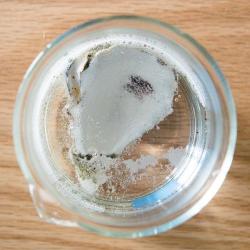Source Institutions
Source Institutions
Add to list Go to activity
Activity link broken? See if it's at the internet archive

Ocean acidification is a big issue due to the amount of carbon dioxide humans release. CO2 in the atmosphere is absorbed into the ocean thus changing its acidity. The more acidic the ocean becomes, the harder it will be for certain animals, like shellfish, to form their shells. In this science snack, you'll see what happens to shells in highly acidic liquids.
- Under 5 minutes
- 10 to 30 minutes
- $1 - $5 per student
- Ages 11 - 18
- Activity, Experiment/Lab Activity
- English
Quick Guide
Materials List (per student)
- Assorted seashells
- Vinegar
- Calcium chloride (CaCl2, sold as Damp Rid in stores)
- Sodium bicarbonate (NaHCO3, also known as baking soda)
- 0.25 molar sodium hydroxide (NaOH, sold as lye in stores)
- Several clear cups or glass containers
- Water
- Spoons
- Marker that will write on plastic or glass
- Optional: pH indicator such as cabbage juice, bromothymol blue, or phenol red
Subjects
-
Earth and Space Science
-
Earth Processes
- Geochemical Cycles
- Weather and Climate
-
Earth Structure
- Oceans and Water
- Atmosphere
-
Earth Processes
-
Physical Sciences
-
Chemistry
- Acids and Bases
-
Chemistry
-
The Nature of Science
-
The Scientific Process
- Conducting Investigations
-
The Scientific Process
-
The Nature of Technology
-
Technology and Society
- Technology and the Environment
-
Technology and Society
Other
This resource is part of:
Access Rights:
- Free access
By:
Rights:
- Creative Commons: Non-commercial Share Alike (by-nc-sa), Exploratorium Teacher Institute,
